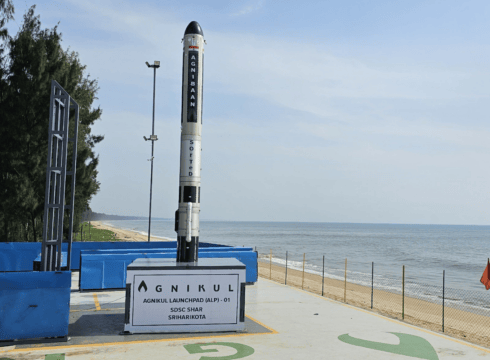The launch, initially scheduled for 05:45 AM IST, was first postponed less than six minutes before the take-off on account of a “technical glitch in the countdown activities”
Agnikul’s previous attempts were marred by technical issues with the lift-off, delaying the timeline for the launch of India's second privately-built rocket
The two-stage launch vehicle called Agnibaan SOrTeD can carry a payload of up to 300 kg into orbit of about 700 km, as per the startup
Inc42 Daily Brief
Stay Ahead With Daily News & Analysis on India’s Tech & Startup Economy
Indian spacetech startup Agnikul Cosmos on Tuesday (May 8) reportedly once again cancelled the test flight of its privately-built rocket, just seconds before the planned launch.
As per Reuters, the launch, initially scheduled for 05:45 AM, was first postponed less than six minutes before the take-off on account of a “technical glitch in the countdown activities”.
Afterwards, a new lift-off time of 09:25 AM was set. However, the launch was put on “temporary hold to check igniter performance”, just five seconds before the launch. Eventually, the lift-off was called off altogether.
This is the fourth time that the company has called off the maiden rocket launch. Even the previous attempts were marred by technical issues with the lift-off, delaying the timeline for the launch of India’s second privately built rocket.
The startup’s first attempt to launch Agnibaan, on March 22, was delayed over “unavoidable circumstances”. On April 6, the launch was yet again postponed before being rescheduled for April 7, which was also rescheduled citing technical issues.
If successful, the launch would have marked a major feat for the country as Agnikul would have become the first company to successfully fly a semi-cryogenic engine (comprising a mix of liquid and gas propellant).
The flight will involve a vertical take-off and follow a predetermined trajectory while performing a series of manoeuvers during the flight. The flight events, as per the startup, have been configured to validate key technologies that will be integral to the company’s future missions.
The two-stage launch vehicle called Agnibaan SOrTeD (SubOrbital Technological Demonstrator) can carry a payload of up to 300 kg into orbit of about 700 km, as per the startup. With a plug-and-play engine configuration, the rocket is 18 metres long and has a diameter of 1.3 metres.
The rocket has a lift-off mass of 14,000 kgs. The startup claims that the launch vehicle is driven by an entirely 3D-printed, single-piece, 6 kN semi-cryogenic engine called Agnilet.
Agnikul’s successful flight follows another homegrown spacetech startup Skyroot’s 2022 launch of the Vikram-S rocket.
Founded in 2017 by Srinath Ravichandran, Moin SPM, and SR Chakravarthy, Agnikul has built the country’s first private launch vehicle for small satellites. It claims to cater to clients looking to launch small satellites and reduce their dependence on expensive large launch vehicles.
Incubated at IIT-Madras, Agnikul was the first Indian startup to sign an agreement with the Indian Space Research Organisation (ISRO) in December 2020. This enabled it to leverage the space agency’s expertise and cutting-edge facilities.
Agnikul last raised INR 200 Cr in its Series B funding round from Celesta Capital, Rocketship.vc, Artha Venture Fund, Mayfield India, among others. As per startup intelligence platform Inc42 Datalabs, the Chennai-based startup has raised $61.24 Mn in funding till date.
It competes with the likes of homegrown players such as Skyroot, Bellatrix Aerospace, GalaxEye, and Dhruva Space.
The spacetech startup’s net loss more than doubled year-on-year to INR 20.2 Cr in FY23 even as operating revenue continued to remain zero.
Agnikul is vying for a piece of the Indian spacetech sector which, as per Inc42 data, is projected to reach a market size of $77 Bn by 2030.
{{#name}}{{name}}{{/name}}{{^name}}-{{/name}}
{{#description}}{{description}}...{{/description}}{{^description}}-{{/description}}
Note: We at Inc42 take our ethics very seriously. More information about it can be found here.


